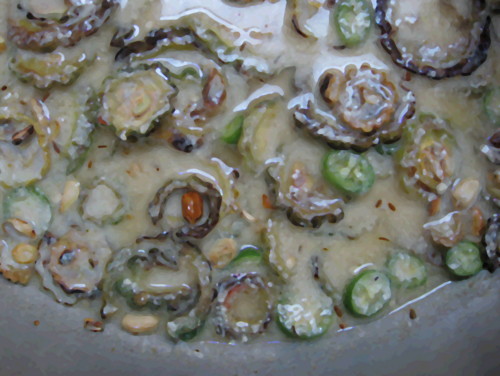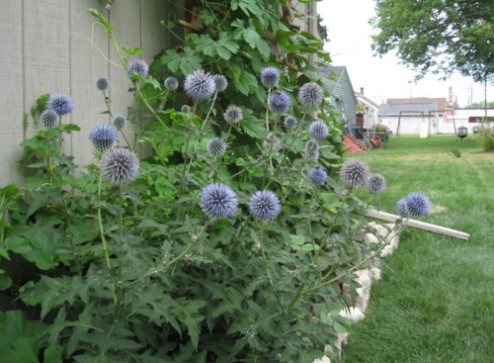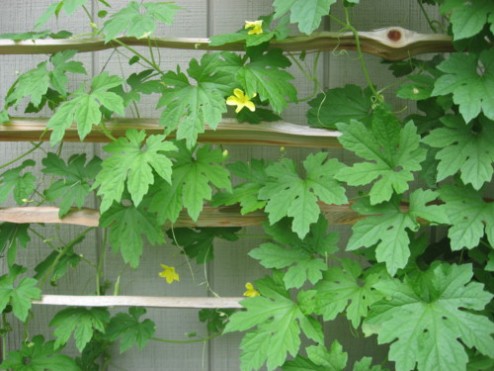Karel Yakhin
Anita’s post for the Kashmiri dish, al yakhni, was, I believe, the first recipe of hers that I commented upon. I remember it well, as she was so kind to suggest this recipe after learning what a huge fan of karela I am, as, although her post made use of al (bottle gourd), the same gravy can be used to cook nadur(lotus stem/root/tubers) as well as karel…
So, because I had a sizable new batch of yoghurt at the ready, and locally-grown bitter melons from both the farmers’ market and my own vines, I decided that the time had finally come to try this dish and do it justice with these freshest of ingredients. (A stock of Lucknowi saunf helps too!)
I was not disappointed. Most delicious…fragrant with saunf, which goes so well with karela. (Bengali cooks would agree!) Rice is a must to accompany this very soothing, comforting dish and allow the aroma of the gravy to bloom. It will definitely be a regular item on my personal menu from now on. Thanks so much for sharing all that you do Anita. May your next year in food-blogging be just as spectacular!
Karel Yakhin*
750 gms karel/karela/bitter gourd/bitter melon, sliced into 1/3″ rounds**
Mustard oil as needed (highly recommended; use another oil if you absolutely must)
1 C dahi/yoghurt
3 t powdered saunf/fennel seeds
1/2 t saunth/dried, powdered ginger
1/4 t whole shah jheera/kala jheera/black cumin
1/4 t whole jheera/cumin/white cumin
green chiles (optional ingredient- not traditional? Anita uses 3 snapped in half; I used two sliced into rounds, retaining the seeds as well)
salt
1)Deep-fry the slices of karela in oil until golden brown; drain well (You may also shallow/pan fry the slices in a few tablespoons of oil if you like- I did so this time, but next time I think I would prefer to deep-fry them as it would be quicker, really, and karela is not highly-absorbent of oil)
2)Place the yoghurt in a bowl; beat or whisk it until smooth; add the saunf and saunth powders; mix well, then add 1 cup of water; set aside. (This should be at room temperature to minimize separation of the yoghurt)
3)Heat 1 teaspoon of oil in a pan over medium-low heat, add both black and white cumin seeds and fry for a few seconds until their aroma is released; turn heat to very low and add the yoghurt mixture.
4)Add the fried karela slices, green chiles, salt to taste, and, if necessary, a bit more water to just cover the vegetable. Bring slowly to a simmer, cover and cook until the chiles are tender. Serve warm with hot rice. Unforgettable!
*Uh…Anita? Why does yakhni change to yakhin in this title? Inquiring minds want to know! 😉
**The rule of thumb that I use for bitter gourd is this: if the interior seed-coatings are red, scrape out the seed cavity. If it is still green/white, slice it and the seeds along with the rind. Ingesting the seeds has been known since ancient times to remove intestinal worms. I’m safe! 🙂
If you’d like to remove some of the bitterness, soak in salt-water for an hour; rinse and drain, or sprinkle the slices with salt, let stand for an hour, place in a muslin or cheesecloth and squeeze out the liquid. I don’t de-bitter the vegetable anymore, as I would not like to compromise nutrients or lose any of the fine flavour.
NEW NOTE!!!! With the latest info: Kashmiris prefer the karela to be cut in half, or quarters if they are larger, and the seed-cavity removed before cooking in this dish. The seeds, with their protective jackets (if not yet red) are deep-fried until golden and crispy, then sprinkled with ground red chiles and salt and served as a side with the yakhin.
I thought I’d share a few photos with you, my readers, of the karela-vine progress…
Globe thistle; behind them, on either side, are trellises which the vines are quickly taking over.
This is a white, Chinese/Thai variety called Hybrid Beauty Winner. This one is still very young; they become paler as they mature and grow, but this one didn’t make it that far!
Asparagus haakesque
Total blasphemy! I know it. Ask me if I care. Something strange happens after you eat the Kashmiri dish known as haak for the first time. It changes your brain chemistry and makes you want more! The sad, dejected, longing look that appears on your face when the last traces are devoured in a bowl with rice, its green, vitamin-rich gravy soaking into the fluffy grains, is totally pre-conceived by those wily, saunf-and-saunth-throwing hooligans. I surrender… but this is my revenge!
Asparagus is in season now in this neck of the woods. I’m ill of the Thai green curry that resists spoiling, I can’t take another round of daalitoy at the moment (or can I?), and although I have val sitting in soaking-water, I want some green stuff now! Some days, I feel like Veruca Salt…
So, green stuff it is! Anita of A Mad Tea Party sent me a recipe for haak, which is made of a special green very similar to collard greens- same species, different variety. There is also a green used by the Chinese and Thai which is yet another similar variety -and can also be used for successful haak-making. It is called kai lan or Chinese broccoli. All are cruciferous vegetables(of the plant family cruciferae, now known as brassicaceae), and the botanical genus-and-species name of all three is brassica oleracea…this single species has been cultivated as well into cabbage, broccoli, cauliflower, brussel sprouts, kohlrabi and kale, as well as the aforementioned greens! So, as you can see, despite being descended long ago from a single plant, there is some difference between them… It took some doing to sort all of this out; I hope we have it straight.
Anita- a regal, proud, and oftentimes giddy Kashmiri Pandit- insists that mustard oil be used for this dish. I implore you to seek it out in Indian shops either under the English name or as sarson ka tel, as it is known in Hindi. Quite pungent when raw, but sweet and mellow upon heating, this is an essential flavour in this dish that, if you were to replace it with another oil and serve it to a weathered haak-eater, would bring scoffs and jeers while your back was turned, but its inclusion will undoubtedly bring them back to your table.
While a pressure-cooker is often used for preparing haak (it saves both time and energy, so why not? Anita pressure-cooks haak for exactly 5 minutes, then immediately releases the pressure- a secret step to keeping the greens green), I cooked this blasphemous version (do I hear noses turning upward?) the old-fashioned, open-kettle way with slow simmering, because I wasn’t sure of the timing and didn’t want to overcook my beloved asparagus (which incidentally, is not anywhere near a close relative of brassica oleracea). Hing/asafoetida is an optional ingredient that non-Kashmiri Madhur Jaffrey uses, but Anita doesn’t. I leave its use up to you.
One more thing: after heating the oil- 2t to 1/2 C- health-level to swoon-level (and sizzling a good pinch of hing), Mrs. Jaffrey adds the greens (1 3/4 lb), covers the pot for 10 seconds, then adds the salt and stir-fries for a minute before adding the water(3 1/2 C) and a few chiles- both green and red. Anita adds the water(2 C) directly to the smoking oil, brings to a boil and adds a pinch of sodium bicarbonate (retains the green colour, but I hear it annihilates a few vitamins), then she adds the greens(1 1/2 lb), cooks them just until they wilt, adds both green and red chiles and some salt, and then … both are in agreement- continuing with the braising until tender. Because Madhur uses a bit more water than Anita, any excess must be boiled off rapidly when the vegetable is tender to reduce it to about 3/4 C or so… Anita’s method is a bit more stream-lined, as it has exactly the right amount of liquid at the end, but then again, she uses a pressure-cooker.
Serve with yoghurt and steamed rice, a flush and a gush and now you’re hooked- er… haaked– too! There is no more to say.
Oh, yes there is!…. If you decide to try the rebel asparagus version, it cooks in 15 minutes at a simmer. Quite done in fact. Lift it out of the pan and place it somewhere gently, then reduce the liquid and re-unite them. Total yum…
Here is some purple asparagus for fun and anti-mango measures………….en guarde you mango-braggarts!:







